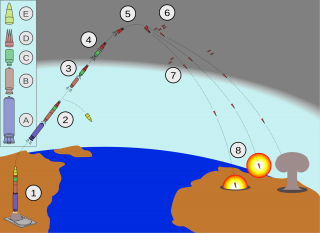The U.S. Military's Big Weakness: Its Nuclear Tipped ICBMs Are Old
And they need to be replaced.
In order to deter nuclear aggression against its homeland and vital interests, the U.S. must demonstrate that its strategic arsenal is capable of surviving an attack and then retaliating with devastating force against the aggressor. In other words, the losses an attacker would suffer must demonstrably exceed any potential gains. Thus, the paradox of nuclear strategy is that when weapons are postured effectively, they will never be used. We buy and maintain nuclear weapons in the hope they will remain in their submarines and silos forever.
The nuclear triad consists of submarines, bombers and land-based intercontinental missiles (ICBMs). Each part of the triad uniquely complicates an aggressor’s calculus when contemplating whether to attack the U.S. or its allies. Secretary of Defense Jim Mattis confirmed last month that the U.S. nuclear deterrent will remain a triad, stating he had been persuaded that “the triad and its framework is the right way to go.”
RECOMMENDED: Why North Korea's Air Force is Total Junk
The Pentagon is currently conducting a Nuclear Posture Review which is expected to be completed by December or early next year. The review is assessing each element of the triad to determine what the U.S. needs to retain its nuclear deterrent to stay ahead of emerging threats. Secretary Mattis specified that the review is not taking into account any specific adversary, but is being evaluated to “face unpredictable circumstances in the future.”
RECOMMENDED: Why Doesn't America Kill Kim Jong Un?
The modernization of the land-based leg of the triad, called the Ground-Based Strategic Deterrent (GBSD), is of particular concern. This is because it will compete for funding with other acquisition priorities such as the F-35 Joint Strike Fighter, B-21 bomber and KC-46 aerial refueling tanker. In addition, other parts of the nuclear triad are due for modernization at the same time, including the Navy’s Columbia-class submarine program, the warheads and bombs maintained by the Department of Energy and nuclear command and control systems.
RECOMMENDED: The F-22 Is Getting a New Job: Sniper
Minuteman-III missiles were first fielded in the 1970s and have undergone various upgrades since. According to Air Force Chief of Staff General David Goldfein, the currently deployed Minuteman-III ICBMs are 45 years old and are overdue for replacement. Hence, the Air Force requested $5.6 billion over the next five years in the fiscal year 2018 President’s Budget Request for the GBSD program
Minuteman-III ICBMs are located in underground silos in Wyoming, Montana and North Dakota. They have a range of at least 6,000 miles and are able to carry up to three warheads each. However, the U.S. currently deploys only one warhead per missile. As of June 2017, the U.S. has 400 deployed ICBMs with about 100 or so in reserve for testing, which occurs four or five times per year.
ICBMs are useful because they act as a targeting “sponge.” An adversary would have to launch at least one warhead at each to destroy them all, depleting its arsenal. If an attacker fails to destroy all of the ICBMs, those remaining could be used to deliver a second-strike response, which would cause great damage to the aggressor. These missiles also force an adversary to target the continental U.S. to even attempt to destroy the entire nuclear arsenal.
The GBSD program cannot be delayed due to budget battles. This would put the reliability of the missiles at risk because the probability of failure at launch increases when their solid-propellant cores age. If there is a postponement of the program, the number of operational ICBMs would significantly drop in the 2030s and create a capability gap since the number of missiles an adversary would have to fire to destroy all the underground missiles would decrease.
In August 2017, the Air Force selected two contractors, Boeing and Northrop Grumman, to begin the second phase of the defense acquisition system, the Technology Maturation and Risk Reduction phase. The Air Force plans to decide on a single contractor for the third phase of the acquisition process in fiscal year 2021. This is where GBSD will be developed, built and tested.
Each component of the nuclear triad is essential to deterrence and needs to be modernized to ensure aggressors are dissuaded from launching a nuclear attack at the U.S. or its allies. Modernization of the land-based triad in particular must not be delayed otherwise its target sponge value and missile reliability will diminish. A nuclear attack is less likely to occur when potential adversaries understand that the U.S. will respond with unstoppable destruction.
Constance Douris is Vice President of the Lexington Institute. She has published articles and white papers on the smart grid, nuclear deterrence, missile defense and European security.

